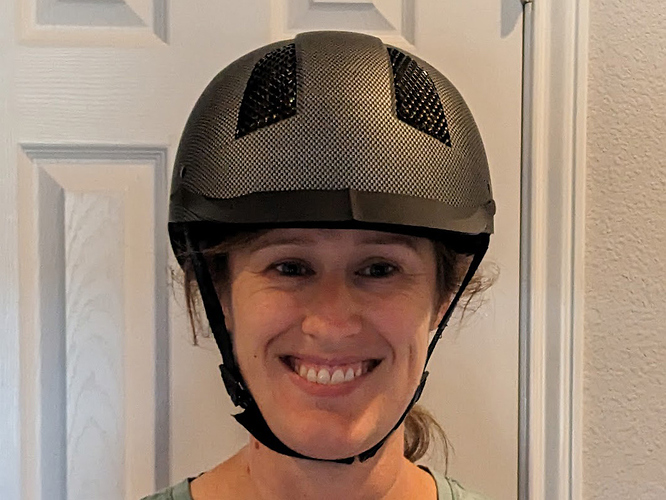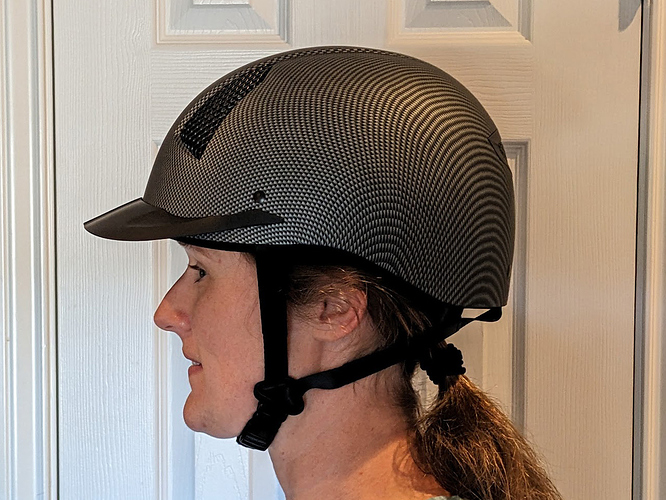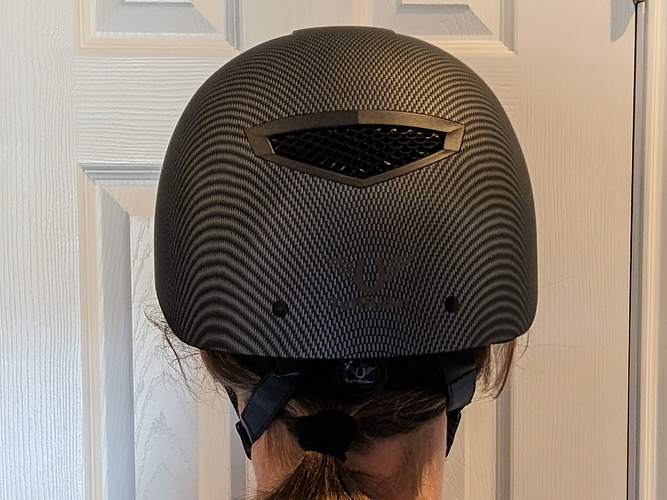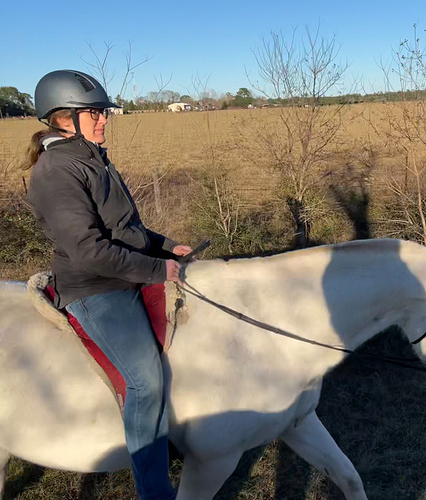I feel like I missed a post. Why hunter hair for all?
I think it is because a spokesperson for the VT study suggested that a full head of hair inside the helmet acted like the MIPS liner to “disengage” the helmet from the skull in case of a fall. Thus, the idea would be that if you have a full head of hair, you basically have a built-in MIPS liner. 
I actually raised the question of whether hair up in the helmet served a similar function to MIPS in the hunter hair thread last year. Glad an expert is weighing in on it!  It is interesting to learn that like most other things in horses there is little actual research backing up the “truths” we’re so often told.
It is interesting to learn that like most other things in horses there is little actual research backing up the “truths” we’re so often told.
Actually Barry has been clear that this is NOT the case in a MIPS helmet.
Having “hunter Hair” in a MIPS helmets causes it to be less likely to have the MIPS system work appropriately.
Em
His quote that was stated above essentially says it’s not clear that MIPS gives any advantages over having hair. So maybe only bald people really need MIPS helmets. But also, as far as I know, no one has actually studied hunter hair in either a regular or MIPS helmet. To me, the point is that there are still many questions remaining about helmets in real world situations since all the tests obviously are simplified/idealized. We’re learning a ton from these new studies but there are still a lot of things left to learn.
“Hair and your scalp act as a natural slip plane and thus helps de-couple your head and helmet which is a good thing. It won’t help much with the linear accelerations but certainly helps with the rotational kinematics by allowing the helmet to move more freely from your head during and impact. MIPS and other rotational technologies try to do the same thing (de-couple). It is difficult to say if any of these add any benefits over and above a full head of hair and may likely be very specific to the location and energy of a given impact. "
I believe Dr. Stephanie Bonin (ASTM Equestrian researcher) has studied hair etc.
I can see if she can comment here.
Em
Thanks for raising this. Yes, I evaluated the effect of MIPS with 3 different headform-helmet interfaces, the bare Hybrid III headform (the higher friction or “sticky” condition), the headform covered in nylon stockings (intermediate friction), and the headform with a human-hair wig (lowest friction). We tested helmets with and without MIPS at 4 impact speeds and 3 impact orientations against a 45-degree oblique anvil. The results show that MIPS reduced rotational kinematics (the type of head movements associated with concussion) under all headform conditions, speeds, and impact orientations tested. The results also show that hair (with a non-MIPS helmet) can reduce rotational kinematics by amounts similar to MIPS on a bare headform. While I didn’t quantify the friction of a bald person’s head, if it is similar to the bare headform, this might mean that a bald person using a MIPS helmet has the same benefit as a person with hair using a non-MIPS helmet during a head impact. However, when we added MIPS to the hair condition, the peak rotational kinematics were further reduced, showing that MIPS provides additional reductions even in the presence of hair. MIPS did not have a significant effect on linear acceleration.
Like any study, there are limitations. I only evaluated on length of hair (about shoulder length) and one model of bicycle helmet; however, given their similarities in construction, I expect that equestrian helmets would have a similar response.
The full paper can be found here: https://doi.org/10.1007/s10439-022-02961-w
Disclosures: I am an injury biomechanist at an independent forensic engineering firm where I conduct research on equestrian, bicycle, motorcycle, and football helmets and their effectiveness. We have no financial relationship with MIPS. Prior to testing, I consulted with MIPS for advice on constructing our drop tower. I am also chair of the ASTM F1163 equestrian helmet committee.
Thank you so much for the info you added to the live chat during the VT webinar last week, and thank you also for contributing your expertise to the discussion here!
Thank you for sharing this. I’m not able to access the full article; can I assume that in the hair condition, hair was down or collected in a ponytail, not up in the helmet worn as riders might?
Yes, the hair was in a ponytail at the back of the head. The goal was to create extra “shear” layers between the helmet and headform with human hair. The hair wasn’t quite long enough to put up consistently and securely under the helmets.
Thank you! I’ve never seen a cyclist do hunter hair, so I figured it was a safe assumption. 
Unless you have a substantial amount of hair (and some people do) and really lump it up in there in an uneven way-- I have never understood why putting hair up would make a substantial difference-- any more than some people having thick/thin hair and short hairdos would impact the fit. I’ve always thought this just didn’t make logical sense if you have normal hair and fan it out evenly.
Over the years of fitting helmets, I have been surprised by the number of women that take their ponytail and twist it up before securing with a hairnet. Then they would wonder why there would be pressure points on their forehead and back of the head.
I’ve always flipped up and fanned out, without the hunter ears because my hair wasn’t thick enough to actually keep them covered. I always knew it was time for a haircut when the end of my ponytail flipped past my bangs.
This is such a horse person sentence. What a shared experience. I immediately knew what you meant.
Here’s the video from the MIPS webinar last night.
It was a great discussion and I thought it was great to see more testing videos to help explain things.
Emily
I would love to see a real life photo of this helmet
There are some on the MIPS group on FB.
Then after the .com/groups/Mipshelmets
Scroll down the page. Was posted by Vali Frank on Dec 15th.
Em
Apologies for the delayed response - been out of town for the holidays! Ignore the fact that my hair is all sorts of awry… but here are a few photos showing it on a real human head.
On this topic of helmet safety, I had a few questions. Perhaps someone who’s involved in sanctioning can suggest answers to eliminate my ignorance. These come from the perspective that safety depends, yes on the helmet design, but even more so on what happens after one purchases it. Thanks everyone for your thoughts!
(1) How do the results of the VT study relate to “approved helmets” now that the results are out? The VT study showed a vast disparity in their “rating”. Would USEF, FEI, etc now indicate (require?) that a helmet must have a ranking score above a cutoff level in the VT study? If so, what level and why? If not, why not? Or does USEF / FEI consider all equally safe & good regardless of their VT study ranking? Or does, USEF / FEI consider that there is more to it than the VT study in order to enforce a ranking selection?
(2) VT studied new helmets. Did they study older helmets, which had been in use for sometime, or do they plan to do that? It seems likely that helmets may degrade with time and usage. This would be invaluable to know. Related to that, sanctioning bodies such as USEF, FEI, etc require that a helmet “time out”. For example, in Jan’2023 the British Riding Club will no longer accept helmets made to SNELL2001 standard. That’s over 20 years of use allowed! In car racing for example, SNELL approved helmets are only allowed to be used for a certain number of years (typically 10 yrs max). Over time, the racer is required to purchase newer model helmets. The helmets are inspected at each race before they are allowed to be used. For racing helmets it is accepted that if it’s dropped on a hard surface, like concrete, that one must discard the helmet. It seems like equestrian helmets are tossed about, stored arbitrarily, etc. yet are assumed to always be in “perfect working order”. I’ve seen them where a horse has stepped on it (when there was a rider head inside it!). That helmet was definitely discarded. I’ve also seem them after they have hit the ground, with the rider unconscious, but no apparent damage to the helmet (that helmet was also discarded just in case). But, the point is, what is the accepted or required safety convention for helmets involved in an incident?
(3) related to the last point, competitions require an approved helmet. But, they are never inspected. An easy way to solve this would be that at the first horse jog, any required safety equipment must be presented to the ground jury / stewards for approval. A sticker would be placed on the helmet (and other required safety equipment) to note its approval at this event, and to prevent the same helmet or equipment being “presented” multiple times by others. Competitions which don’t have a jog could have the rider present that helmet to the show office for approval and stickering. For competitions were a horse passport is presented such as at the show office, the inspection / stickering could be done then and there. The sticker on the helmet makes it easy for stewards and other officials to notice that any mounted rider is wearing an approved helmet.





